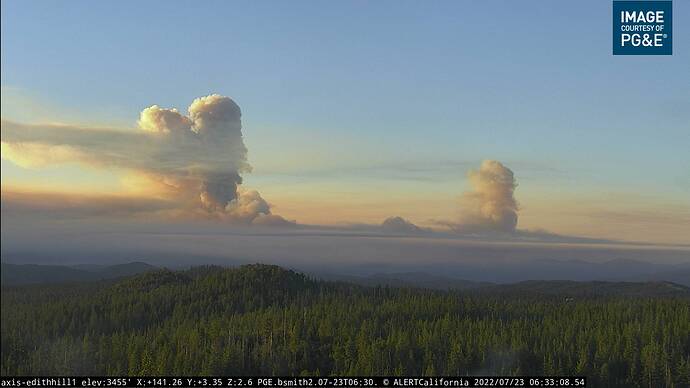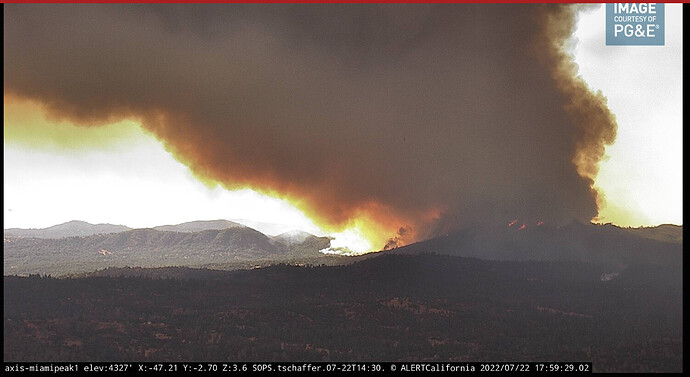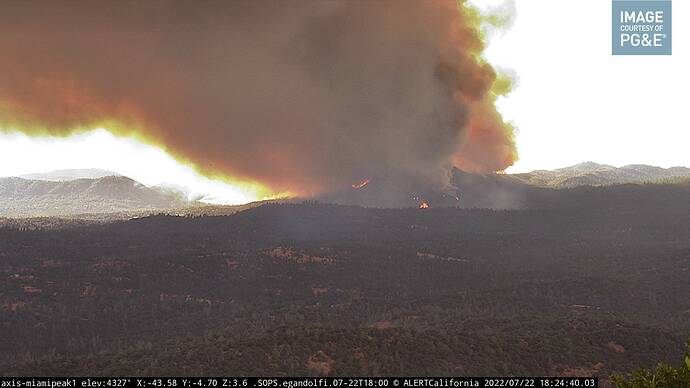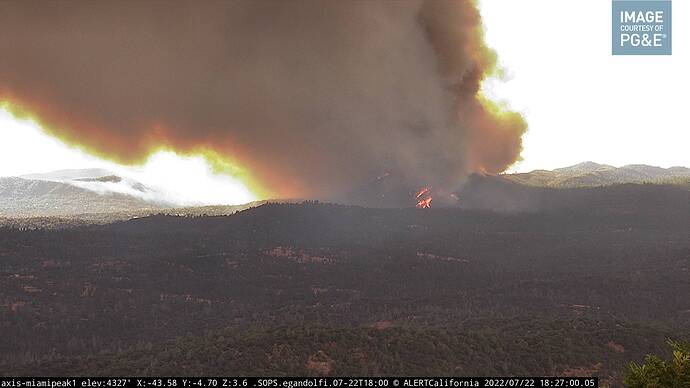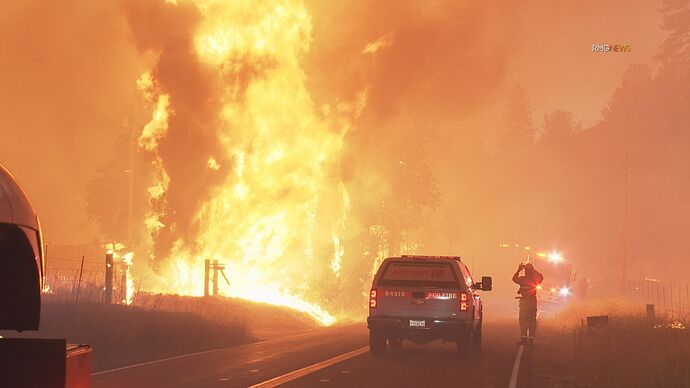Looks like that fire is tipping its hand for what to expect today! Heads up y’all! Im going to go work on my marine layer dance for you…
The 3 to 5am heat map update on Caltopo:
(Usual 2-3 hour delay for signatures. Also smoke will give some false heat signatures with this size of fire -FYI )
https://caltopo.com/map.html#ll=37.51756,-119.8859&z=13&b=t&o=f16a%2Cr&n=1,0.25&a=mba%2Cfire%2Cmodis_mp
History and Honoring the Past
A little grace from the Mods over the length of this post. I hope it is worthwhile in causing people to think. Late last night and this morning I looked through a fire progression model (WFA) made for this fire shortly after it started. Thankfully it over-predicted the Oak’s progress in size and shape. Primarily it instituted excessive lateral spread instead of the more linear shape it currently occupies. In addition, I believe it was initialized without the benefit of local conditions, so they didn’t attenuate the 1H, 10HR, RH, and Wind Speed like we see in this area after the sun sets. I imagine today’s run will be far more accurate. But an apocalyptic map slapped me into thinking. With that in mind, I’d like to revisit the Chief’s (@FireHawkC3100) comments he made during the Washburn Incident.
Thankfully, the Washburn was under the influence of different geographical features so I didn’t necessarily agree. But his point is extremely relevant and wise. If you look at some of the few fires we’ve had in our area that were in the same Awhahnee and Oakhurst “bowl” there is a definite pattern. It is the same pattern that the Oak has established. Look at fires like.
2014 Courtney Fire
2014 Junction Fire
2017 Ben Fire
2017 Detwiler
And to credit the Chief, the 1961 Harlow Fire. Unless trumped by some transient meteorological condition, all have a very definite pattern to their major spread, from the northwest to the southeast based on our normal diurnal wind pattern and geographical funnel.
Currently the Oak Fire is approximately five miles northwest of the point of origin of the Harlow – that is upwind – read that again. I wasn’t on it, but there are folks on this site who were. The bottom line is that we probably have very similar fuel and weather conditions. The final side of the fire triangle, topography, is certainly completed based on proximity. Those who don’t know, the Harlow occupied the record books for decades with its rate of spread.
The historical perspective is one of the things we need to keep in the back of our minds, whether we are on the line, in the ICP, or at your property. Honor the potential, simple as that. If you look at the towns of Nipinnawasee and Ahwahnee today you would never know they burned in 1961. That demonstrates that homes and infrastructure can and will be replaced. But lives can never be replaced - ever. Honor the potential, I hope I am off base with my concern and get smacked.
A slightly deeper dive if you are interested is at 1961 Harlow Fire Mariposa County California
It was boss
It’s getting with it. Looking from Miami Peak you can see quite a bit of fire activity as well as spots…
I could see it from outside of coalinga.
Deadwood had a good view.
https://www.alertwildfire.org/region/sierra/?camera=Axis-Deadwood2
…thought you lived in Twain Hart…beautiful small community…favorite Vet there…thanks for all your updates
Caught a fire whirl on the deadwood camera. I bet that was interesting.
https://youtu.be/zTJEl9iqmz4
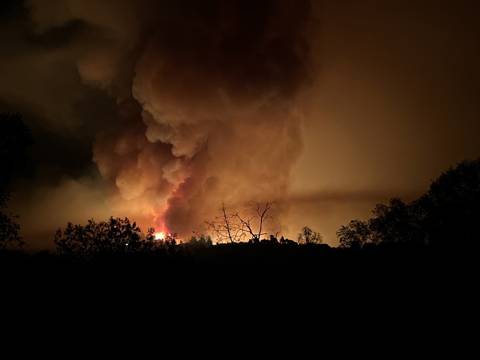
Great educational Post! Well worth the length and well written. I think the phrase "Honor the potential" can not be stressed enough. I wasn’t around for the Harlow, but it was a top topic in FB Classes through the 80ies.
Additional mid level moisture moving in from the south east today will increase the chances of pyrocu development. Important to watch the column today and not focus on the fire front with the spotting that’s going on.
Can we say, today it is important to watch the column, the fire front, and the spotting? Keep your head on a swivel please!
Excellent commentary and very much appreciated from me.
Extended Frequencies
Air Tactics FM 169.200
A/G 159.345 (tac 18, tone 192.8)
Rotor Vic 119.075 (and TFR)
Addl ground tacs ordered CDF Tacs 26, 27, 28, VFires 24, 25, 26
@apx8000 @trishaswcfirewx
IMT-Geek, the pattern you are describing extends further than the Madera/Mariposa area. If you look at the 2015 Butte Fire in Amador and Calaveras Counties you will see the same footprint. Several Fresno County Fires have burned in a similar pattern. I personally refer to this as the “right turn”, because local factors, such as river drainages and diurnal winds, would lead one to believe the fire should be spreading up canyon more to the north and east; instead the fire heads southeast, thus the right turn.
Several fires, such as the Rim and and Creek encountered a reduced fuel loading, usually due to another recent fire (the 1987 Complex and the Aspen Fires for those cited) and burned more to the east. This seems to be the case for the Washburn Fire which was up against the Mariposa Grove fuel treatment areas.
I don’t know what causes this phenomenon, I suspect it has to do with the upper level winds. I first made note of it with the Stumpfield Fire in the late 1990’s - it wanted to run toward Miami Mtn. instead of northeast where I would think the up canyon winds would have moved it. In those days though, we were pretty successful in catching fires in the first or second burn period and you needed to dig deep into fire history to see the pattern. With the megafires we been having in the last decade, examples are becoming much too frequent.

